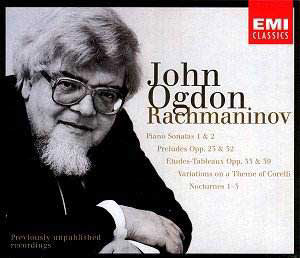Immediately one’s curiosity, if not suspicion, is aroused
when one reads that these performances, recorded in 1988, were previously
unpublished. One has to ask why? Apparently they are derived from unissued
recordings made for the now defunct Collins Classics shortly before
Ogdon’s untimely death (and after his breakdown). They are now released
by EMI under license from Richard Ogdon who owns their copyright. He
commented that they had been sponsored by a company that had gone into
liquidation. Consequently they languished unreleased until Mr Ogdon
acquired their copyright. He lived abroad and was preoccupied with family
concerns during the 1990s and so their release was delayed some fourteen
years. Yet, playing devil’s advocate, one might be forgiven for wondering
why Collins Classics did not recognise these performances by a renowned
exponent of one of the most popular of classical composers and move
energetically to release these recordings themselves? It is a pity that
EMI did not include a note of explanation in the booklet – an omission
that does no favours for them or the reputation of John Ogdon.
CD1 is devoted to the Opp 23 and 32 Preludes (10 in
the former and 13 in the latter). Omitted is the famous Prelude in C
sharp minor, one might say infamous judging by the number of times Rachmaninov
had to play it as an encore. Probably the best known after that is the
Op 23, G minor (Alla marcia) prelude. Here it begins imperiously well
and there is incandescence but the gorgeous romantic tune does not tug
at this reviewer’s heart as it did in earlier Ogdon recordings. There
is a wanting too of finesse and poetry in the lovely Andante D major
prelude that follows. Of the Op. 32 preludes the turbulent No. 6 in
F minor lacks focus. Yet there are pleasures. The substantial B minor
(Lento) is rapt and softly pensive in the outer softer passages but
the forte more passionate middle section is a trifle uncomfortable.
The galloping rhythms of the sunny G sharp minor delight, and the playful
B major (allegretto) and the mysteriousness of the concluding D flat
(Grave) preludes come off well.
CD2 comprises the two sonatas and Three Nocturnes.
Both sonatas are written on the grand scale, their virtuoso bombast
balanced by Rachmaninov’s lovely intimate romantic melodies. Rachmaninov
completed his Sonata No. 1 in D minor in 1907 shortly after the Second
Symphony. Like that work it is conceived on a large scale with the outer
of the three movements, some 12 and 15 minutes duration. Ogdon’s robust
reading has many fine moments, especially in the quieter stretches,
but sometimes the denser passages are not so clearly delivered as in
his prime. The later Second Sonata composed between the Third and Fourth
Piano Concertos is more assured and fluent. Ogdon beautifully realises
the deep-set melancholy and resignation (and defiance) inherent in the
lovely central movement. Of the Nocturnes, the spiky, restless F sharp
minor is driven hard, while the central F major and the dream-like F
sharp minor beguile.
The Etudes-Tableaux fare well. The Op. 33 set has tender,
soulful readings of No. 1, F minor and the lovely No. 8, G minor and
a gruff but also more insightful No. 3 in C minor. The old virtuosity
and clarity, power and finesse illuminates No. 5, D minor and No. 6
the E flat minor, while one might imagine, like Respighi who orchestrated
No. 7, the E flat Etude, as a bustling fair scene. Respighi also orchestrated
four of the Op. 39 Etudes to make up his Cinq Ètudes-Tableaux.
Op. 39, No. 2, heavily influenced by the Dies Irae, is given a most
beautifully evocative reading here (in his interpretation, Respighi
imagined the sea and seagulls). The turbulent 6th, A minor with its
scurrying galloping rhythms suggested ‘Little Red Riding Hood and the
Wolf’, and the dour No. 7 in C minor a VIP funeral. Indeed you might
imagine from Ogdon’s forceful, trenchant playing the funeral scene in
piercing rain with tolling bells. Finally Respighi saw No. 9 in D as
an oriental march. Ogdon presses it forward strongly. Elsewhere the
fiery No. 5, the E flat (Appassionato) is fervent although maybe not
as forceful as in his earlier recordings.
The 3 CD set is rounded off with a very satisfying,
lucid reading of the Variations on a Theme of Corelli Here Ogdon delights
with delicacy and humour of phrasing in the early variations, the bizarre
musings of the Adagio misterioso variation viii, and the grotesqueries
of the Agitato xiii. His intermezzo (A tempo rubato) glistens, and the
Andante (come prima), xiv and L’istesso tempo xv, are flowing and beautifully
grave while the Meno mosso xvii and Coda haunt.
There are many delights in this curiously delayed set
including strong readings of the sonatas and evocative Etudes-Tableaux;
but sometimes denser material lacks clarity and passion occasionally
appears to be more a matter of dynamics rather than fervour of the heart.
Nevertheless, for John Ogdon’s many enthusiasts, this is a set worth
acquiring -- but they are advised not to dispose of their treasured
Rachmaninov recordings from the earlier, golden years of this gentle
giant’s career.
Ian Lace


